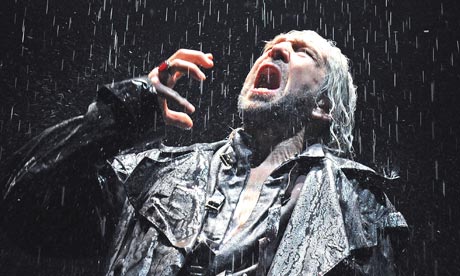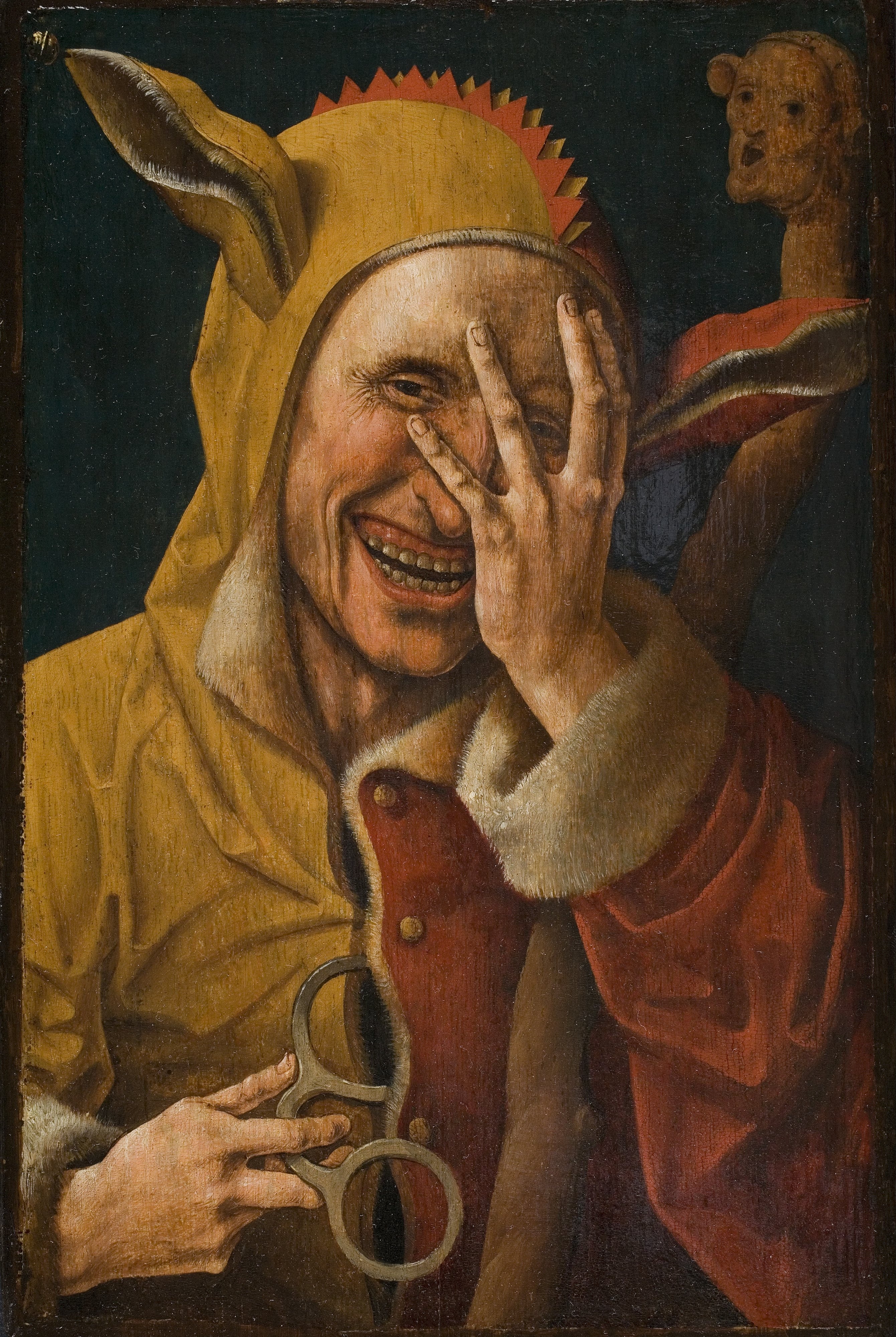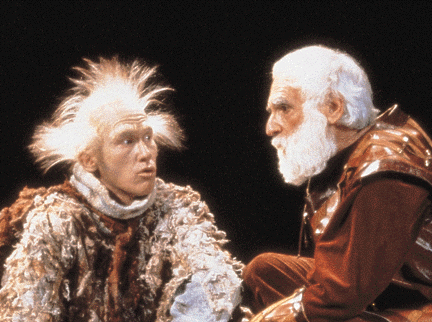
King Lear is the archetypal tragic hero. Throughout the play it's unclear what Lear's hamartia s is. From scene to scene it changes from rage, to ego , to folly. For me, Lear is a deeply flawed character whose mental and physical deterioration leads to peripeteia that no one can save him from. His anagnorisis arrives when he's surrounded by dead bodies.
As AC Bradley writes: "Shakespearean tragedies stem from the tragic flaws of the protagonist." I feel that Bradley is completely right, not only can this view be applied to Lear but also Othello (his tragic flaw is jealously and possessiveness), Hamlet (inability to act to avenge his father's death ) and Macbeth (ambition).
So what is Lear's tragic flaw?
For AC Bradley it's his hubris that renders him 'half generous and half selfish. For spark notes his tragic flaw is that he values appearance above reality. I think it's hard to pick one tragic flaw for Lear as Simon Russel Beale (the absolute G who played King Lear in NT Live production- 2014) says we never get to see Lear at his best. We never see the Lear that the fool loves or the Lear that Kent worships. All we see is an idiotic old man that makes bad decision one after the other that spiral out of his or anyone else's control. Every bad decision he makes points to another fatal flaw. The love test is the biggest moment of folly. Why is he doing this? What will he gain? as SRB it's a 'catastrophic criminal mistake." On the penalty of death I think that Lear's fatal flaw is his blindness. He is blind to everyone and everything but what makes it worse is that, at points you feel that he purposefully makes himself blind. He can't bear to see things he has done so shifts the blame onto something else so that he doesn't have to come to terms with the fact that he has caused all of this.
Couple of quotes to back this up:
"See better Lear and let me still remain/ The true blank of thine eye" - Kent 1.1
"Which of you shall we say doth love us most"- Lear 1.1
"Where are his eyes? Either his notion weakens, his discernings are lethargied."- Lear
"Come not between the dragon and his wrath"
"Well let it be so. Thy truth be thy dower."
"Dearer than eyesight, space and liberty"- Goneril 1.1 during the love test. This is obvs bullshit but Lear can't see this
"When majesty falls to folly.... This hideous rashness"- YAAAS KENT! YOU TELL HIM BETCH...
Source Material
There have been many changes from the various primary source materials that Shakespeare may have used to write King Lear. As Trevor Nunn writes: "Late 19/early 20th century versions of Lear...perceived as kind and gentle.. a man goaded.. by two wicked sisters". Fairy tale motif.

In the original King Leir, Leir is mourning for the loss of his wife. Immediately this makes the audience sympathise with Leir but also provides a motive for the love test. As SRB says handing over 1/3rd of your kingdom to a foreign power is politically suicidal. But in Leir it's easy to blame his grieving for a sudden blindness on how he shall rule his kingdom.

But in Lear it's just like da fuq? It comes out of nowhere and there doesn't really seem to be a motive. I think the authorial purpose of Shakespeare was to involve the audience in the peripeteia of Lear. Initially the audience is very distant from Lear, basically we see him as a crazy loony. But through his self realization the audience becomes much more sympathetic allowing their to be catharsis for both Lear and the audience by the time Lear/Cordelia etc. dies.
Compared to all the sources Shakespeare is able to add depth and dimension to Lear. Lear is never really black or white but rather occupies the shades of grey. His 'hideous rashness' coupled with his evocation to help the nation's poor shows him as an extremely complex psychological character.
CONTEXT!!!
In the Court of Chancery the records of 1588 to 1589 show a sensational case that was publicly arousing interest in London.
Sir William Allen, a leading figure in the Company of Merchant Adventurers and former Lord Mayor of London, had three daughters, all married, one to a Frenchman Francis Verzelin. Allen, having reached an age, wished to relieve himself of the burden of his possessions and divided his property between the three and arranged he should stay at each in turn.
But once in possession of the houses and property, his daughters then treated him ill, begrudging all service and comfort. The daughters claimed that coal was an unnecessary expense for him, 'limited his fire' making him bitterly cold, and treated him with scorn and disdain. They abused his staff, called his servants 'fussocks'. Allen died in misery and cursed his daughters.
Love Test
This is the first time that we see Lear in the play but unfortunately he is presented as a rash ruler with no perspective. As mentioned countless times before, Lear has no clear motive for the love test and therefore we immediately start to question him.
Compared to the source material (love test seen in Monmouth's, Leir and Faerie Queen) Goneril and Reagan known about the love test therefore are able to prepare and sabotage Cordelia's speech. But Shakespeare consciously removes this element so that all 3 sisters start on a level playing field- we are able to respect them for their intelligence and how politically savvy they're.

Sigmund Freud asserted that Cordelia symbolises Death. Therefore, when the play begins with Lear rejecting his daughter, it can be interpreted as him rejecting death; Lear is unwilling to face the finitude of his being. Alternatively, an analysis based on Adlerian theory suggests that the King's contest among his daughters in Act one has more to do with his control over the unmarried Cordelia.
Compared to the source material (love test seen in Monmouth's, Leir and Faerie Queen) Goneril and Reagan known about the love test therefore are able to prepare and sabotage Cordelia's speech. But Shakespeare consciously removes this element so that all 3 sisters start on a level playing field- we are able to respect them for their intelligence and how politically savvy they're.

Sigmund Freud asserted that Cordelia symbolises Death. Therefore, when the play begins with Lear rejecting his daughter, it can be interpreted as him rejecting death; Lear is unwilling to face the finitude of his being. Alternatively, an analysis based on Adlerian theory suggests that the King's contest among his daughters in Act one has more to do with his control over the unmarried Cordelia.
Productions + The Love Test
- Sam Mendes (2014) - National Theatre. Makes the love test in a v. v. public setting. They are surrounded by his retinue and there are microphones that are able to project this image of a show or spectacle. As Simon Russel Beale says the love test is a 'living will' and the placing in such a public setting shows the distance between Lear and his daughters. Suggests that familial relationships are based on power/land rather than love.
- Trevor Nunn (2008)- RSC. Much more intimate- Lear is in all his military regalia with his daughters crowded around him. For me it's a much more homely feeling and doesn't really match up to the cool/dictatorish setting of Mendes.
One of the interesting lexical choices that arise from the love test is the lexis of measurement. Throughout the love test, Lear quantifies love in order for it to have any meaning. In turn, Goneril and Regan are able to appropriate his own language back to him in order to persuade him of their 'genuine love'.
"But now her price has fallen"
"Beyond what can be valued, rich or rare"
"...prize me at her worth..."
"I tell you all her wealth"
'Love' is an abstract noun. it is supposed to be all encompassing. But Lear's interpretation of love is much more sinister. It is used to breed an environment of competitive individualism that causes the sisters to try and outvie each other. Furthermore it also places importance on people in terms of what they can do for him rather than how good of a person they're.
Later on in the play Lear says to Goneril: "Darkness and devils. Degenerate bastard." This is absolutely awful to say to anyone let alone your own daughter. But once Goneril has gone against Lear she is immediately a monster, an other. When she pets his ego he loves her but as soon as she begins to question him the tables turn. This 'hideous rashness' plagues everyone; even though Goneril is a bitch, she makes a valid points about why she's so angry at Lear. Which leads me onto the next point....
Importance of Lear's retinue
Throughout Shakespeare's plays there are many silent servants that are seen as background characters. They are mostly onlookers and are overlooked by critics and readers. But KL offers an exception to this. The Knights have been given more interpretative parts than other walk on parts. They way they are staged can effect the whole interpretation. If the 'men are so disorded, debauched and bold' as Goneril remarks then surely her anger is valid. Who the hell wants 100 knights treating your hallowed court like the fucking playboy mansion. BYE FELICIA! But if the knights are civilised like the Jonas Brother pre Nick trying to be a male stripper then you see the malice of the two sisters
There are no stage directions about how the knights should act but Goneril insists that the 'your disordered rabble strike my people and make servants of their betters."
Reunion Scene- Folio vs Quarto
Their influence is particularly evident in the differences between the Quarto and Folio. The reunion scene means that the presence of attendants transforms a private conversation into a public scene. In the Quarto the only characters on stage are Lear, Cordelia, Kent a doctor and gentleman.
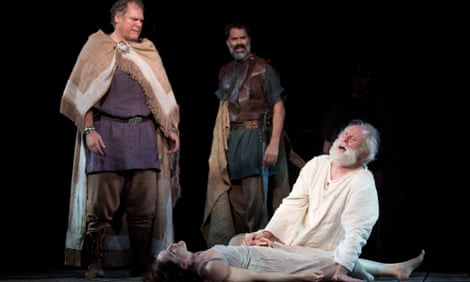
In the Quarto the reunion is extremely intimate and allows for a de-politcised, familial focus on the Lear- Cordelia relationship. But in the Folio the servants who carry him in makes his entrance reminiscent of a royal ceremony. Bringing him back in a royal chair for Jacobean audiences may raise the audience's expectations of Lear and eventually Cordelia's rise back to the throne in the source material King Leir. Shakespeare, an audience baiter and original thug.
Edmund's self wounding
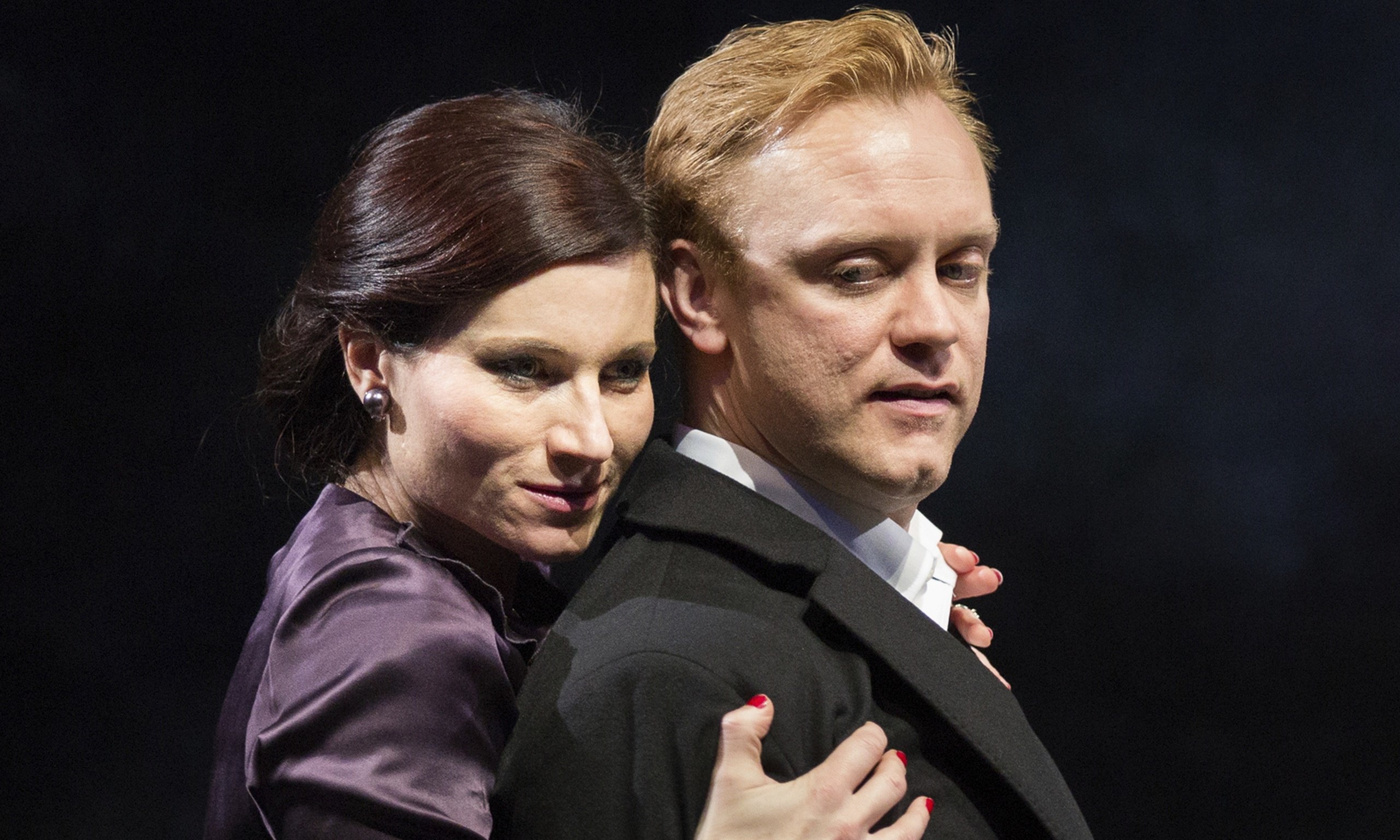
Servants mirror the authority of their master: they function as a visible representation- a literal embodiment- of their master's power. When Gloucester makes his servants try and catch Edgar the servants are not only a display of his authority; they are an outward representation of Gloucester's deceived inner conviction about his son. The servants function as a physical embodiment of Gloucester's mental determination, malicious intent and firm belief in Edgar's villainy.
Doubling up of actors

The metatheatrical effects of doubling medium-sized parts such as Cordelia and the Fool have long been noted by critics. In the case of Lear's lost retinue, the loss of his royal attendants and thus his royal power and authority would have been emphasized at the Globe when the actors who played his attendants kept reappearing as the new servants of other master. These actors- on stage but no longer Lear's- function as a repeated visual reminder of Lear's lost status and authority. and a physical sign of the transfer of power from his court to the households of his daughters and their husbands.
Storm Scene
We find that, as A.C.Bradley puts it, the storm provides a dramatic centre, which helps Lear find out about human nature. He also discovers that nature is totally unconcerned with human affairs. Lear sees himself in the storm; the many manifestations of the storm are analagous to the conflicts in his own life.
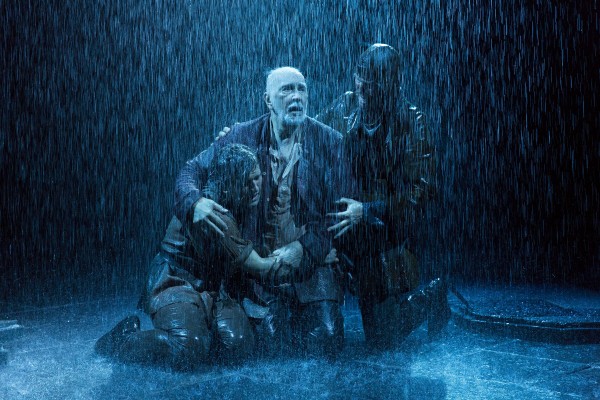
In contemplating the plight of Lear, the reader or playgoer is influenced to sympathy, and is made finely aware of the shortcomings of human nature. In a manner above any other, Shakespeare, in King Lear, reveals the purpose of human struggle. A human's ideas of morality, and his methods of achieving it, are not necessarily, or hardly ever, right
What does the storm symbolise?
- Mental madness = inscape vs outscape
- Confusion and lack of control is his mind
- Chaos created in the state/individual/family/nation universe
- Anger of nature therefore a divine punishment
- An agent of God and associates it with his daughters
- Natural/political
- Lear is the storm and the language reflects his chaos
Although Lear is clearly quite insane the grandeur of his poetry is able to give him a status and magnificence that defies his humble station.
In this painting, Lear seems to have a sense of authority. You have to admire a man who is able to take on nature. Because the power mankind has is finite compared to transient nature. He is a 'mortal God...image of male authority'. "Blow winds, and crack your cheeks! Rage, blow! You cataracts and hurricanoes, spout" The monosyllabic imperative exclamatory statements are able to show the sheer power Lear has, or thinks he has. The apocalyptic imagery that he uses could suggest that Lear has elevated himself to such a position that he feels that like God, he is able to create or destroy the world.
However there is also evidence that Lear starts to gain wisdom in this scene. There is a widening scope as Lear starts to focus on the rural poor, an oppressed part of society in Elizabethan England. In 1590s in an England racked by poverty, unemployment and commercial depression would have said that theirs was a better world or that human inventiveness had restored a good and just society. There was a subclass of cripples and hobbling wounded, all virtually un-pensioned. Nature enemy of the poor- bad harvests created shortages that sent price soaring. Food riots broke out + troops called in to restore order. Malnutrition grew chronic- 1597 the average wage was less than a third of what it had been a century before. Staple foods of the poor= beans, peas, cereals of all types. Loaf of bread still cost a penny- once bought a loaf weighing 3 ½ lbs by 1597 now shrunk to 8 oz.
QUOTES:
"O I have ta'en/ Too little care of this"
"Poor naked wretches, wheresoe'er you are"
"Take physic, pomp./ Expose thyself to what wretches feel."
"That thou may'st shake the superflux to them/ And show heavens more just"
"How shall your houseless heads and unfed sides... defend you"
His empathy starts to increase, as Trevor Nunn writes"King can journey through the guts of a beggar". He starts to question himself, why haven't I have done anything about this before? I should place myself in this situation? This situation which he truly embraces when meeting Tom O'Bedlam. Furthermore, this is the only time we start to see Lear caring about others more than himself. Throughout Act 1 and 2, Lear sees the fool as a source of entertainment but know he genuinely care about him and almost becomes a surrogate son.
How dost, my boy? Art Cold? Come your hovel. Poor fool and knave, I have one part in my heart That's sorry for thee.
"The tempest in my mind doth from my senses take all feelings else/ Save what beats here filial ingratitude"

V But sympathy starts to increase for him because if we get to the end and don't feel anything for Lear but contempt than the tragedy hasn't worked. This scene is instrumental in playing with our emotions so that it truly becomes a tragedy.
Stripping Section
Both Edgar and Lear strip. But because this is Lear's profile I'll focus on him. The motif of clothing is
quite important throughout the play. When Kent starts a fight about Oswald, most of his insults
revolve around his clothes that make him pretentious.
" "Nature disclaims in thee; a tailor made thee."
As Kent claims: "I am much more than my out-wall"
References to clothing are closely linked to ideas about appearance and reality. Outward appearances are often deceptive in King Lear.
The apparel of all Lear's closest companions on the heath- the Fool, Kent and Edgar - is significant. All 3 are humbly dressed. In site of their inferior status - signified by their clothing- servants are frequently the source of hope, charity and justice in King Lear.
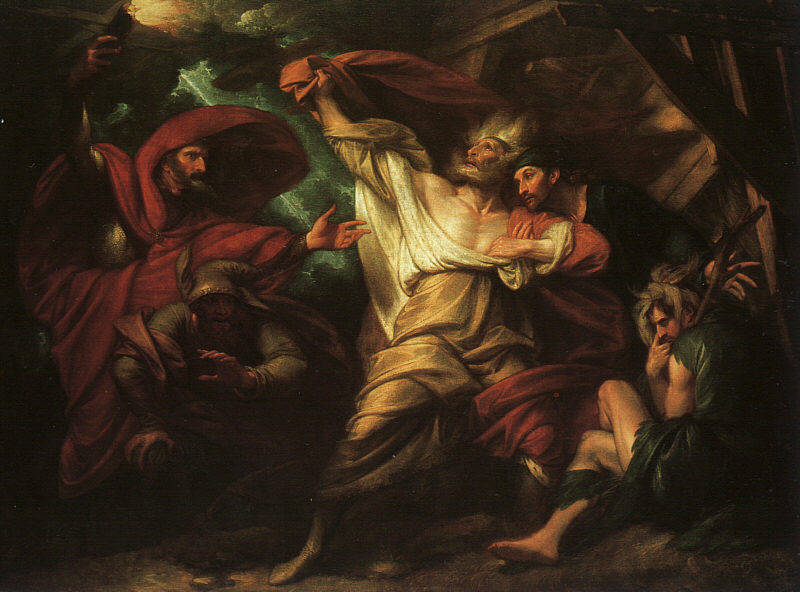
In the first scene, immaculately dressed as a military dictator, Lear is in control, confident
enough to allow himself a little chuckle as he puts his disfunctional daughters on the spot. By
the time we get to the scenes on the heath he seems to have physically shrunk, shambling
across the stage wearing baggy vest and underpants, later in a hospital gown or pyjama
bottoms.

Ceremonial garments are able to conceal the truth. With his royal garb on, Lear cannot see beyond the trappings of majesty. Which leads to the v. emotive scene where Lear strips: "Off, off you lending! Come unbutton here." Lear realises that he no longer has any power, so why must he take part in the ceremony anymore? Also he removes his clothes because he now needs to see beyond appearances
Without the trappings of ceremony, Lear is able to see underneath it all men are equal. Hierarchy is a social construct but it doesn't actually mean anything.
According to Arden edition of Shakespeare it is common for the Fool and Kent to try and stop Lear from stripping off. Some productions allow him to strip completely, which would be so strange for a modern audience. This old man who symbolised power, wisdom and authority has become vulnerable and has almost become the beast. Whereas other productions allow Lear to be in an undershirt to show the debasement of his societal position.
Mock Trial
What is the purpose of the mock trial?
- Parody of the love test in 1.1
- Trial conducted by a fool, lunatic, pretend lunatic = comment on human justice?
- Undermines all trial that are carried out by authority figures in King Lear
"The play is hard on organised human society and institutions of any kind"- Trevor Nunn

The absurd nature of the trial of the two stools, which Lear addresses as "she-foxes," is grotesque in its humour, especially when Lear makes Tom o' Bedlam his "robed man of justice," which, as the
audience can visually see, is hilarious given that this title represents a pun on the only article of clothing he has on. The ridiculous nature of the mock trial is continued when the Fool is appointed as
"yoke-fellow of equity," which, given his nature as a Fool is rather inappropriate, to say the least The scene as a whole shows the way in which Lear, in his madness, has converted the tragedy of what has happened to him into something of a farce, which interestingly does not make us feel his tragic situation is one that he faces with dignity.
The substantive readings of F are perceived by many as superior to those of Q, while Q’s ‘mock trial’ scene has repeatedly proved an immensely powerful moment in performances of the play, speaking directly to twentieth-century audiences informed philosophically by the ‘theatre of the absurd’, pioneered by writers such as Samuel Beckett as a way of illustrating the desperate futility of man’s existence (a huge thematic concern in King Lear).
That the scene was cut from Shakespeare’s later adaptation may suggest that it didn’t have the same poignant resonance with Jacobean audiences, though whatever the case may have been, the Folio can nonetheless be seen by this example to be, among many other things, a valuable source of evidence for theatre historians as well as literary critics.
The disintegration of Lear’s seemingly well-ordered kingdom is spelled out for us in a whole series of scenes in which there is, it seems, no ray of light. Horror is piled on horror, culminating in the blinding of Gloucester. The placement of the mock trial of Reagan and Goneril is directly before the blinding of Gloucester. One trial of his daughters follows the brutal trial of Gloucester in the next scene.
The mock trial is the last time that we seen the Fool. His last line: "And I'll go to bed at noon"- I'll be discussing the importance and the disappearance of the fool in a separate blog post.
Lewy Body Dementia/ Insanity
It is extremely difficult to ascertain where in the play King Lear the hero becomes mad. The abnormal behaviour, the extreme irritability, the exhibition of disinhibited thoughts may be the harbinger of psychosis or his premorbid traits. When the Duke of Kent pleads lenience in Lear for Lear's youngest daughter Cordelia, he banishes them from his realm and explodes: "Peace, Kent! /Come not between the dragon and his wrath."
Unlike other Renaissance dramatists, who used 'mad scenes' for comic effect, Shakespeare seems intent on a serious portrayal of madness in 'King Lear'. There are different types of madness in the play. Lear's rash actions of 1.1 can be viewed as political insanity. Lear compares his madness to the torments of hell and struggles to frantically to retain his wits. The other characters are horrified by his loss of reason and try desperately to keep him sane. But is it pointless?
As Simon Russell Beale says- As an actor you have to decide whether you want to play a Lear that is already mad or one who is descending into madness as the play progresses. I chose to play a Lear who is already mad.“In this one, I thought I bet Shakespeare, being the acute observer of human nature that he is, would have studied old men,” he said. “I thought: I’m going to do a bit of research.” King Lear could have been suffering from Lewy Body dementia, the actor Simon Russell Beale has suggested, as he discloses the medical research he undertook before taking on the role.
Lewy Body dementia occurs in quick stages that involve frightening hallucinations, with many remarking that they see barking dogs: "The little dogs and all". The disease is linked to Parkinsons and many suffers say that they have overwhelming feelings of shame and anger









